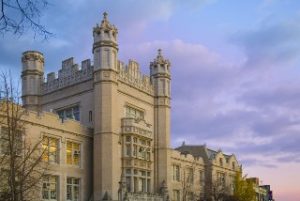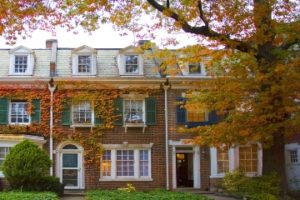 Built between 1793 and 1798, the Flatbush Dutch Reformed Church was designated a landmark by the New York City Landmarks Preservation Commission in 1979. It is the third church built on the site, which has been in continuous use for religious purposes for longer than any other location in New York City.
Built between 1793 and 1798, the Flatbush Dutch Reformed Church was designated a landmark by the New York City Landmarks Preservation Commission in 1979. It is the third church built on the site, which has been in continuous use for religious purposes for longer than any other location in New York City.
Church Avenue is in the heart of the Flatbush section of Brooklyn. Originally a Dutch colony, the Town of Flatbush was annexed into the City of Brooklyn in 1894. The street is home to the Flatbush Dutch Reformed Church, which has been an active religious institution in Brooklyn since it was founded in 1656 (current structure dates from 1796).
The Flatbush area experienced significant growth during the second half of the 19th century as the Brooklyn, Flatbush, and Coney Island railroads made it accessible for wealthy business owners to live there. The early 20th century saw a wave of construction of four-story walk-up and 6-story elevator buildings, making the area around Church Avenue as densely populated as parts of Manhattan. Throughout most of the 20th century, Flatbush had a mainly Jewish, Irish, and Italian population. The 1960s to the 1980s saw an influx of African American and Caribbean immigrants. Flatbush today is an incredibly diverse neighborhood with a population of over 200,000. A wide variety of stores and restaurants selling goods and food from around the world can be found on Church Avenue.
PLACES OF INTEREST
-
Flatbush Dutch Reformed Church
-
St. Paul’s Church
St. Paul’s Church in the Village of Flatbush was originally formed in 1836. The current Gothic-style structure was built in 1877.
-
Erasmus Hall High School
 Erasmus Hall High School is the 3rd oldest high school in the state of New York. Founders include Alexander Hamilton, Aaron Burr, and John Jay.
Erasmus Hall High School is the 3rd oldest high school in the state of New York. Founders include Alexander Hamilton, Aaron Burr, and John Jay. -
Victorian Flatbush
 Built around the beginning of the 20th century, Victorian Flatbush maintains a suburban feel in the middle of the city. It is made up of a number of neighborhoods featuring Victorian-style, single-family homes, including BID-adjacent Albemarle-Kenmore Terrace, Caton Park, and Prospect Park South.
Built around the beginning of the 20th century, Victorian Flatbush maintains a suburban feel in the middle of the city. It is made up of a number of neighborhoods featuring Victorian-style, single-family homes, including BID-adjacent Albemarle-Kenmore Terrace, Caton Park, and Prospect Park South. -
Prospect Park/Parade Ground
 Prospect Park was built in the 1860s and is arguably the greatest masterpiece of landscape architects Frederick Law Olmstead and Calvert Vaux. The southernmost section of the park, known as the Parade Ground, is one block north of the Church Avenue BID. Originally built as an area for military drills and exercises, the Parade Ground is now one of Brooklyn’s largest sports facilities.
Prospect Park was built in the 1860s and is arguably the greatest masterpiece of landscape architects Frederick Law Olmstead and Calvert Vaux. The southernmost section of the park, known as the Parade Ground, is one block north of the Church Avenue BID. Originally built as an area for military drills and exercises, the Parade Ground is now one of Brooklyn’s largest sports facilities.
